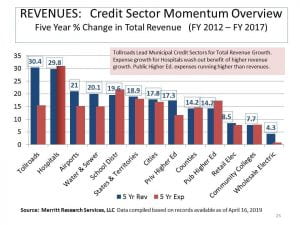Tollroads Edge Hospitals for the Municipal Bond Credit Sector Revenue Honors
Tollroad and Hospital Sectors easily led all other municipal bond credit sectors when it came to annual total revenue growth over the recent five year period spanning 2012 through 2017.
Tollroads saw a median increase of 30.4%, barely edging out hospitals (systems and independent obligors), which grew by 29.8%.
The slowest growing sector belonged to the wholesale electric sector, which only saw a five year bump of 4.3%. The wholesale electric group, also frequently referred to as public power authority joint action agencies, has been showing positive margins as their missions are often limited to the large generating power plants that they financed.
The credit sector summary analysis comparing the growth in total revenues to total expenses from 2012 to 2017 was compiled by Merritt Research Services, LLC using audited reports from approximately 10,000 municipal bond borrowers.
Tollroads
The Tollroad sector was the clear leader among the major municipal credit sectors. Its total revenue pace was about double that of its total expenses during the period from 2012 to 2017. The strong revenue growth experienced by the sector doesn’t mean that every municipal bond tollroad borrower raised more than it took in every year; but, the vast majority has been doing that lately. For Fiscal Year 2017, 75% of all tollroads reporting a five year trend showed positive net income.
Relatively new toll projects and, in general, tollroads located in the Sun Belt, were among those that have had the fastest revenue growth since 2012. Among those with standout five year revenue growth trends were Central Texas Turnpike System, Tampa-Hillsborough County Expressway Authority, Miami-Dade Expressway Authority and E-470 Public Highway Authority in Colorado.
Hospitals
A solid spurt in hospital revenues was dampened by the fact that the Hospital sector was one of four sectors that experienced an even faster escalation in expenses.
Growing at a tad slower pace than the Tollroad Sector, the Hospital Sector’s total revenues increased by 29.8%; but, the increase was still short of the 31% total expenses growth rate for the same five year period. Much of the fault for the mismatch is the uneasy conflict between rising health care costs and countervailing resistance to escalating charges for services by private, government insurance and consumers. The Affordable Care Act also contributed to rising revenues. The Act boosted hospital patient activity and patient collections. Another factor boosting the rapid growth in individual hospital obligor revenues has been the expansion of revenues tied to hospital mergers and acquisitions. Some of the largest hospitals seeing more than doubling of their five year total revenue numbers are BMC Health Systems (MA), Northwestern Memorial (IL), Yale New Haven Health System (CT) and Providence St. Joseph Health (WA). Six percent of all independent hospitals or hospital systems saw a decrease in revenue over the 2012- 2017 period.
Other Strong Showing Municipal Credit Sectors
Airports and Water & Sewer credit sectors also displayed a solid revenue growth trend that also outpaced expenses.
Airport total revenues climbed 21% higher during the five year period, in line with robust air travel activity, while expenses grew only 15.2% during the same period.
Essential purpose municipal utility borrowers, related to water and sewer enterprises, saw revenues go up 20.1% compared to a 15% upswing in expenses.
The trend improvement in revenues and expenses worked together to enhance bondholder protection as both sectors also saw outstanding median long term debt levels decline since 2012.
Revenue and Expense Trend Imbalance Flashes Caution for Public Higher Education
Struggling with a host of challenges, including declining demographics and rising tuition, the Public Higher Education Sector experienced the widest imbalance in revenues to expenses among all the major credit sectors. Although the median percent change in expenses was up 17.3 between 2012 and 2017, total revenues lagged behind with an increase of only 14.2%. Public institutions which saw the most shrinkage in their enrollment numbers were the most prone to have negative deficit trends, as might be expected. A similar predicament was apparent for private higher education institutions as well.
Richard A. Ciccarone, President & CEO of Merritt Research Services, LLC and Co-Owner of MuniNet LLC

